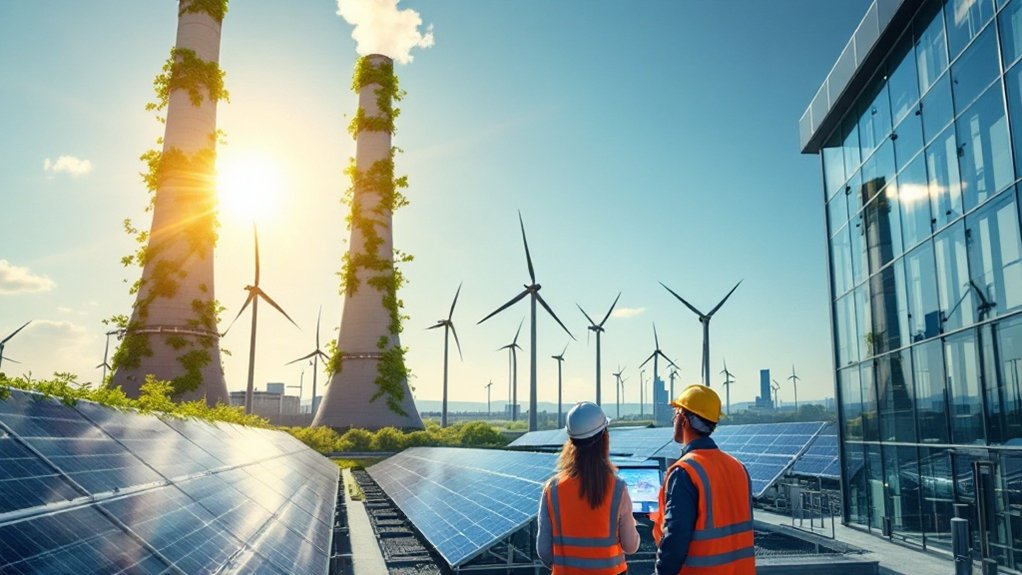Decarbonization strategies are reshaping industries by emphasizing sustainability and emission reduction. Companies are increasingly adopting renewable energy, enhancing energy efficiency, and investing in carbon capture technologies. This transformation is further propelled by the electrification of transportation and the development of sustainable supply chains. However, the implications of these shifts extend beyond mere compliance. The interplay between innovation, policy, and economic resilience invites a closer examination of the future landscape of industry practices.
The Shift to Renewable Energy Sources
The shift to renewable energy sources represents a critical pivot in global efforts to combat climate change. This transformation involves harnessing natural processes, such as solar, wind, hydro, and geothermal energy, to replace fossil fuels. As nations increasingly recognize the urgency of reducing greenhouse gas emissions, investments in renewable technologies are surging. Solar panels and wind turbines, once considered niche, are becoming mainstream energy solutions. Additionally, advancements in energy storage technologies are addressing intermittency issues, making renewables more reliable. Governments are implementing policies to incentivize clean energy adoption, driving innovation and job creation in the sector. This collective movement towards a sustainable energy future not only aims to mitigate climate change but also seeks to enhance energy security and promote economic resilience. Moreover, the transition to renewables is expected to create jobs in renewable energy, contributing to a more robust and resilient job market.
Implementing Energy Efficiency Measures
How can organizations effectively reduce their energy consumption while maintaining productivity? Implementing energy efficiency measures presents a viable solution. Organizations can conduct energy audits to identify areas of excessive consumption and prioritize improvements. Upgrading to energy-efficient lighting and HVAC systems can notably lower energy usage without compromising comfort. Additionally, promoting employee awareness and engagement in energy-saving practices can enhance overall efficiency. Smart technologies, such as automated controls and monitoring systems, enable real-time tracking of energy consumption, allowing for timely adjustments. Moreover, investing in energy-efficient equipment not only reduces energy costs but also often leads to lower maintenance expenses. By adopting a systematic approach to energy efficiency, organizations can achieve substantial reductions in energy consumption while ensuring operational effectiveness. Furthermore, energy-efficient technologies lead to substantial savings and emissions reductions, making them a critical component of a successful energy efficiency strategy.
Advancements in Carbon Capture and Storage
As industries endeavor to meet ambitious climate goals, advancements in carbon capture and storage (CCS) technologies are becoming increasingly essential. Recent innovations have enhanced the efficiency of capturing carbon dioxide emissions from industrial processes, making it more feasible for businesses to integrate these systems. Developments in materials science have led to more effective sorbents and solvents, improving capture rates while reducing costs. Additionally, the integration of CCS with renewable energy sources is being explored, allowing for a more sustainable approach to carbon management. Enhanced monitoring and verification techniques also guarantee the long-term integrity of stored carbon, addressing safety and regulatory concerns. Moreover, robust policy frameworks are crucial to support the development and deployment of these innovative carbon management solutions. Collectively, these advancements position CCS as a crucial component in the broader strategy for achieving significant reductions in greenhouse gas emissions.
Electrification of Transportation
Carbon capture and storage technologies play an important role in reducing emissions from industrial processes, but the transportation sector also presents significant opportunities for decarbonization through electrification. Shifting to electric vehicles (EVs) is an essential strategy, as it replaces fossil fuel dependency with cleaner energy sources. Governments and private sectors are investing in EV infrastructure, including charging stations and renewable energy integration, to facilitate this shift. Additionally, advancements in battery technology are enhancing the range and efficiency of electric vehicles, making them more accessible to consumers. Public transportation systems are also moving towards electrification, reducing urban air pollution and greenhouse gas emissions. Overall, the electrification of transportation is a fundamental component in achieving broader climate goals and promoting sustainable mobility. California’s commitment to renewable energy will further support the transition towards electric vehicles and sustainable transportation options.
Sustainable Supply Chain Practices
While traditional supply chains often prioritize cost and efficiency, sustainable supply chain practices focus on minimizing environmental impact and promoting social responsibility. Companies are increasingly adopting strategies that incorporate eco-friendly materials, energy-efficient logistics, and waste reduction methods. These practices not only aim to lessen carbon footprints but also enhance brand reputation and customer loyalty. Collaboration with suppliers that share sustainability goals is critical; this fosters transparency and accountability throughout the supply chain. Additionally, businesses are leveraging technology, such as blockchain and IoT, to track sustainability metrics and optimize resource use. Ultimately, sustainable supply chains contribute to a more resilient economy, aligning corporate strategies with the urgent need for community engagement and ethical considerations in production and distribution processes.
The Role of Policy and Regulation in Decarbonization
Policy and regulation play a critical role in driving decarbonization efforts, particularly through mechanisms such as carbon pricing. By establishing a financial cost for carbon emissions, governments can incentivize businesses to adopt renewable energy sources. These strategies not only promote environmental sustainability but also stimulate innovation in clean technologies.
Impact of Carbon Pricing
Effective decarbonization relies heavily on the implementation of carbon pricing mechanisms, which serve as an essential tool for incentivizing emissions reductions. Carbon pricing establishes a cost for carbon emissions, prompting businesses to adopt cleaner technologies and practices. This market-driven approach encourages innovation and investment in low-carbon solutions, as companies seek to minimize their financial liabilities. Additionally, carbon pricing can enhance the competitiveness of industries that lead in sustainability, while penalizing those that lag behind. By integrating carbon costs into financial decision-making, policymakers can drive significant change towards a low-carbon economy. Ultimately, the effectiveness of carbon pricing is influenced by regulatory frameworks, public acceptance, and the robustness of the pricing structure itself, all of which determine its impact on emissions reduction efforts.
Incentives for Renewable Energy
The success of decarbonization strategies is closely tied to the promotion of renewable energy sources, which can be greatly influenced by targeted policies and regulations. Governments worldwide have implemented various incentives, such as tax credits, subsidies, and grants, to encourage investments in renewable energy technologies. These financial mechanisms lower the barriers for businesses and individuals to adopt clean energy solutions, thereby accelerating the shift away from fossil fuels. Additionally, regulatory frameworks that set ambitious renewable energy goals create a stable environment for long-term investments. By fostering innovation and competition, these policies not only enhance energy security but also stimulate economic growth. Ultimately, effective incentives for renewable energy are vital for achieving meaningful progress in global decarbonization efforts.
Frequently Asked Questions
What Are the Economic Benefits of Decarbonization for Industries?
The economic benefits of decarbonization for industries include reduced operational costs, enhanced competitiveness, access to new markets, improved brand reputation, and potential regulatory incentives, ultimately leading to sustainable growth and long-term profitability in a changing economic landscape.
How Does Decarbonization Impact Job Creation in Affected Sectors?
Decarbonization greatly influences job creation across various sectors. It fosters demand for green technologies and renewable energy, resulting in new employment opportunities. Additionally, the shift encourages workforce retraining, enhancing skills for sustainable industry roles.
What Role Does Consumer Behavior Play in Decarbonization Efforts?
Consumer behavior greatly influences decarbonization efforts by driving demand for sustainable products and services. As individuals prioritize eco-friendly choices, businesses adapt their practices, fostering innovation and ultimately contributing to broader environmental goals and industry transformation.
How Can Smaller Companies Implement Decarbonization Strategies Effectively?
Smaller companies can implement effective decarbonization strategies by prioritizing energy efficiency, adopting renewable technologies, engaging employees in sustainability initiatives, and collaborating with industry partners to share resources and best practices for emissions reduction.
What Are the Potential Risks Associated With Decarbonization Initiatives?
The potential risks associated with decarbonization initiatives include financial burdens, operational disruptions, regulatory challenges, and technological uncertainties. Companies may struggle with implementation, face resistance from stakeholders, and encounter market fluctuations affecting their sustainability efforts.
Conclusion
In summary, decarbonization strategies are reshaping industries by fostering a commitment to sustainability and innovation. The shift to renewable energy, enhanced energy efficiency, and cutting-edge carbon capture technologies are pivotal in reducing greenhouse gas emissions. Additionally, the electrification of transportation and sustainable supply chain practices further amplify these efforts. As companies adapt to these transformative strategies, they not only contribute to global climate objectives but also enhance their resilience and drive economic growth in a rapidly changing environment.

